Initially this guide displays common flowers of all colors that are blooming right now in our area. Use the selectors to view rare species, to view flowers blooming any time, to restrict the output to a certain color, or to search by name.
The Jemez Mountain Herbarium located at PEEC has a specimen collection of over 1,000 plant species that are found in the Jemez Mountain region. This guide was developed as a subset of this collection to help in the identification of the most prevalent flowering plants in Los Alamos County. Most of the plants shown here are native to the area, though a few were introduced to the region.
Monocot and both simple and composite flowering dicots are covered in this guide. This information is included in each description and potentially makes it easier to identify the different plants.
- monocot – seed has 1 embryonic leaf; flower parts com in multiples of 3; leaves have parallel veins
- dicot – seed has 1 embryonic leaves; flower parts com in multiples of 4 or 5; leaves have scattered veins
- simple flower – single, symmetric flowers; usually 3 to 6 petals that emerge from the flower center
- composite flower – multiple, tiny flowers arranged on a single base, typically rays around a disc; each tiny flower has its own seed
Most of the plants represented here are classified as forb/herb which are plants without significant woody growth. However, some flowering shrubs and trees have been included. Many of the later can also be found in the PEEC Tree Guide. This guide does not include any noxious weeds from the area. These are covered in the PEEC Invasive Plant Guide.
You can get additional information on local blooms by joining PEEC Wild Plants. More detailed descriptions can be found in Plants of the Jemez Mountains Volumes 2 and 3, which are available in the PEEC gift shop.
Flower References
American Southwest Plants
Annotated Checklist and Database for Vascular Plants of the Jemez Mountains
Colorado Rocky Mountain Wildflowers
Flora of North America
Foxx, T., Martin, C., and Hoard, D., 2018 Plants of the Jemez Mountains Volume 2: Wildflowers: Showy Monocots and Common Dicots.
Foxx, T., Martin, C., and Hoard, D., 2019 Plants of the Jemez Mountains Volume 3: Composites.
eNature
Lady Bird Johnson Wildflower Center
National Garden Association
Native Plants Society of New Mexico
New Mexico Flora
Rocky Mountain Flora
Southwest Desert Flora
Wildflowers of the United States
US Department of Agriculture Natural Resources Conservation Services
US Forest Service
Subject Area Experts (all guides)
Steve Cary (butterflies)
Beth Cortright (insects)
Terry Foxx (invasive plants)
Leslie Hansen (mammals)
Richard Hansen (fish, mammals)
Dorothy Hoard (butterflies, trees)
Chick Keller (flowers, herbarium)
Shari Kelley (geology)
Kirt Kempter (geology)
Garth Tietjen (reptiles)
David Yeamans (birds)
Web Development and Content Management
Pat Bacha
Jennifer Macke
Graham Mark
Akkana Peck
Contact
Please contact us for local nature questions and sightings. We welcome comments, corrections, and additions to our guides.
For more information about local nature, please visit our Nature Blog or subscribe to PEEC This Week.
Make Selection
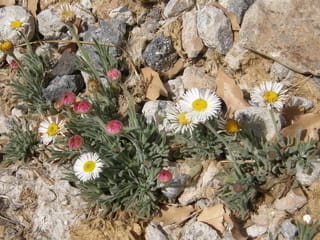  Photo: Chick Keller 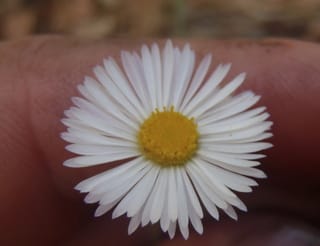  Photo: Dan Beckman | Running Fleabane, Running Daisy, Tracy's FleabaneERCO28 (Erigeron tracyi, Erigeron colomexicanus )Family: Asteraceae (Daisies) Size: 6 - 12 in (15 - 30 cm) Growth: forb/herb; biennial Blooms: Feb 01 - Dec 01 Flower: composite; white with yellow center, may have purple color on edges; a single flowerhead per stem made up of 100 ray florets and over 200 disc florets Leaf: dicot; basal leaves close together and wider toward the tip; stem leaves few and narrow; hairy Fruit: archenes topped with bristles Status: native; common Habitat: pinyon-juniper --- foothills, open areas, and woods Typical location: Red Dot Trail Spreads via runners during summer and fall. Similar in overall appearance to Spreading Fleabane but has runner similar to Whiplash Daisy. Info Photos Distribution |
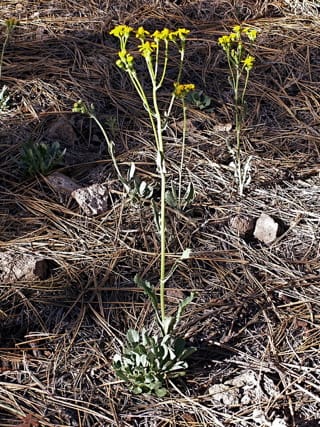  Photo: Chick Keller 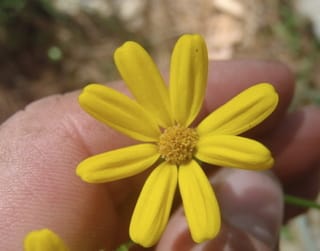  Photo: Dan Beckman | New Mexico GroundselPANEN (Packera neomexicana, Senecio neomexicanus)Family: Asteraceae (Daisies) Size: 12 - 24 in (30 - 61 cm) Growth: forb/herb, subshrub; perennial Blooms: Mar 09 - Jul 10 Flower: composite; yellow; 5 to 14 ray florets around 40 or more disc florets; clusters of between 3 and 20 flowerheads Leaf: dicot; wider at the tip than base; may have teeth and hairs; mostly located around the base Fruit: white puffs of hairs attached to seeds similar to dandelions Status: native; common Habitat: ponderosa --- foothills, montane, subalpine, woodlands, openings Typical location: Perimeter Trail to Water Canyon Plants are often crowded together with an unusual abundance of flowers for each plant. Plants can often be fairly variable. Info Photos Distribution |
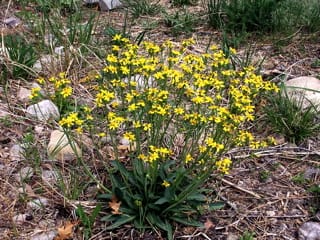  Photo: Chick Keller 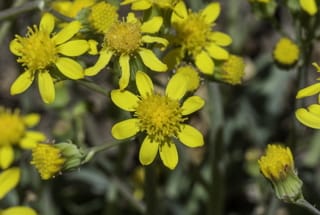  Photo: Craig Martin | Wooton's Ragwort, Wooton's SenecioSEWO (Senecio wootonii)Family: Asteraceae (Daisies) Size: up to 24 in (61 cm) Growth: forb/herb, subshrub; perennial Blooms: Apr 01 - Jun 18 Flower: composite; yellow; on stems with few leaves terminating in a flowerhead; one long petal per flowerhead Leaf: dicot; have small teeth and long stalks with wings Fruit: achenes, ribbed and hairless Status: native; common Habitat: ponderosa --- montane, woodlands, openings Typical location: Quemazon Trail When flower buds first appear they seem to only have disk flowers but the ray flowers appear with time. Plants in full sun bear a large number of flowers. Info Photos Distribution |
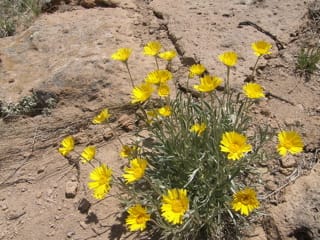  Photo: Chick Keller   Photo: Craig Martin | Perkysue, Perky SueTEAR4 (Tetraneuris argentea, Hymenoxys argentea )Family: Asteraceae (Daisies) Size: up to 15 in (38 cm) Growth: forb/herb; perennial Blooms: Apr 01 - Aug 15 Flower: composite; yellow; found on the top of long leafless stalks; a dozen or so notched ray florets stick out very straight from the central disc florets Leaf: dicot; fuzzy silver leaves Fruit: achenes topped with scales Status: native; common Habitat: pinyon-juniper, ponderosa --- niches in solid rock areas Typical location: Lower Quemazon Trail Hearty plant that is the earliest blooming yellow daisy. Has been used heartburn and in a lotion for eczema. Info Photos Distribution |
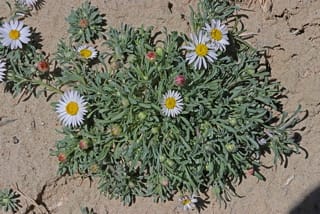  Photo: Jerry Oldenettel 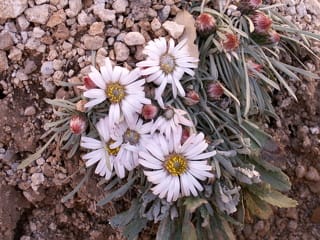  Photo: Chick Keller 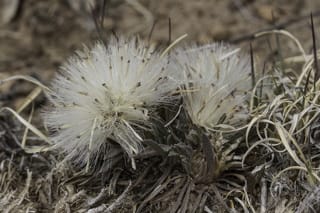  Photo: Craig Martin | Stemless Townsend Daisy, Easter Daisy, Silky Townsend DaisyTOEX2 (Townsendia exscapa)Family: Asteraceae (Daisies) Size: 1 - 7 in (3 - 18 cm) Growth: forb/herb; perennial Blooms: Mar 10 - May 19 Flower: composite; white to pinkish petals surrounding a yellow center Leaf: dicot; gray-green; spatulate in shape; usually hairy Fruit: achene with fine, slender bristles on top Status: native; uncommon Habitat: pinyon-juniper --- grasslands, sage; plains, valleys Typical location: Burnt Mesa Trail Plant grows from a woody taproot from which the leaves and flowers grow directly. Thus, the plant is stemless or nearly so. Info Photos Distribution |
  Photo: Jerry Oldenettel 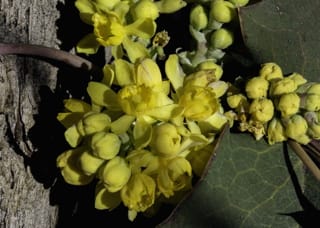  Photo: Craig Martin 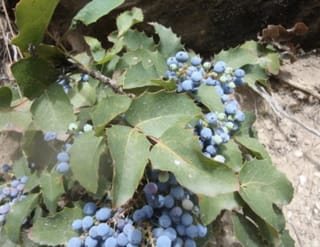  Photo: freejinn | Creeping Barberry, Creeping Oregon GrapeMARE11 (Mahonia repens)Family: Berberidaceae (Barberries) Size: 12 - 24 in (30 - 61 cm) Growth: shrub, subshrub; perennial Blooms: Mar 15 - May 30 Flower: simple; yellow; long clusters of up to 50 flowers; 6 petals Leaf: dicot; bluish green with some leaves in pinks and oranges Fruit: matte blue berries Status: native; common Habitat: ponderosa --- foothills, montane, subalpine, woodlands Typical location: Satch Cowan Trail A sprawling evergreen with small fragrant flowers. The berries attract birds. In the fall the leaves of this groundcover turn bronze. Info Photos Distribution |
  Photo: Chick Keller 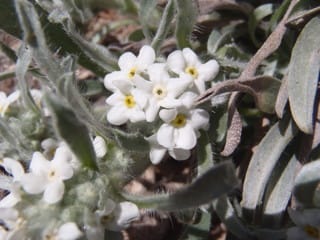  Photo: Craig Martin | James' Cryptantha, James' Hiddenflower, James' CatseyeCRCIJ (Cryptantha cinerea, Oreocarya suffruticosa)Family: Boraginaceae (Borages) Size: up to 4 in (10 cm) Growth: forb/herb, subshrub; perennial Blooms: Apr 15 - Sep 10 Flower: simple; white with yellow corolla tube; dozen of clusters per plant that elongate with age Leaf: dicot; narrow, linear leaves; sparse hairs Fruit: four identical smooth nutlets Status: native; uncommon Habitat: pinyon-juniper, ponderosa --- open areas, semi-desert Typical location: Anniversary Trail One of the most shrub-like of the genus with many branches and bristly hairs. Found in open areas below 8,000 ft (2,400 m). Info Photos Distribution |
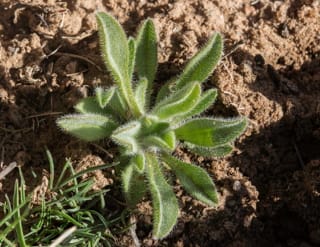  Photo: Craig Martin 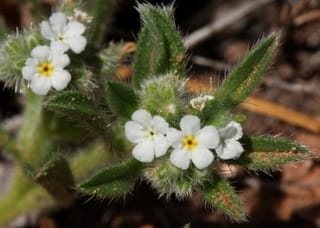  Photo: J.N. Stuart 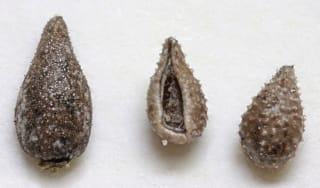  Photo: Andrey Zharkikh | Thicksepal Catseye, Thicksepal Cryptantha, Thicksepal HiddenflowerCRCR3 (Cryptantha crassisepala)Family: Boraginaceae (Borages) Size: up to 4 in (10 cm) Growth: forb/herb; annual Blooms: Apr 01 - May 31 Flower: simple; tiny; white with a little yellow; 5 petals Leaf: dicot; oblanceolate;hairy; form a rosette about an inch across Fruit: 4 nutlets, one taller than the others Status: native; common Habitat: scrubland --- sandy soils in semi-desert Used by Navajo as a lotion for itching and muscle fatigue. Info Photos Distribution |
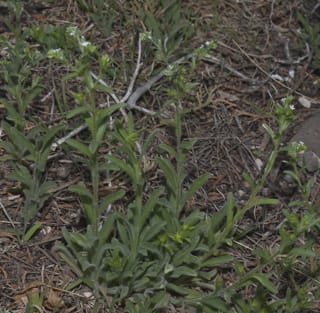  Photo: Marion Stelts 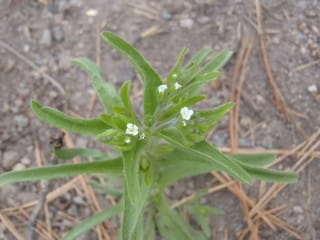  Photo: Craig Martin 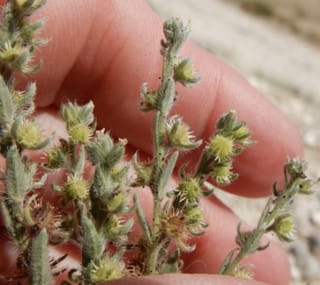  Photo: Ellen Hildebrandt | Flatspine Stickseed, Flatspine Sheepburr, Western SticktightLAOC3 (Lappula occidentalis)Family: Boraginaceae (Borages) Size: up to 32 in (81 cm) Growth: forb/herb; annual, biennial Blooms: Apr 15 - May 30 Flower: simple; light blue to white; small and hairy; radially symmetrical; 5 petals Leaf: dicot; lance-shaped with pointed end at the bottom; alternate arrangement; hairy Fruit: star-shaped nutlets Status: native; common Habitat: disturbed soil, ponderosa --- semi-desert, foothills, montane, open areas Typical location: Lower Pueblo Canyon The seedpods are easily carried away by animals and humans brushing against the plant. The Navajo used the plant in a poultice for insect bites and other skin irritations. Usually found below 8,500 ft (2,500 m). Info Photos Distribution |
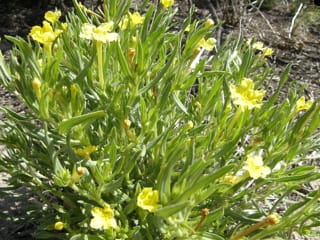  Photo: Chick Keller   Photo: Jerry Oldenettel 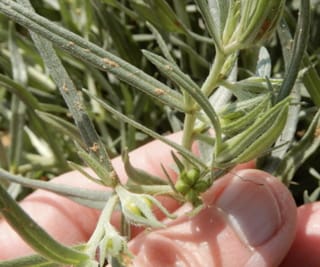  Photo: Ellen Hildebrandt | Narrowleaf Stoneseed, Fringed Puccoon, Fringed GromwellLIIN2 (Lithospermum incisum, Batschia linearifolia)Family: Boraginaceae (Borages) Size: up to 12 in (30 cm) Growth: forb/herb; perennial Blooms: Apr 19 - Jun 01 Flower: simple; yellow, 5 wavy petals; changes with the season: large and wide at first, then becoming trumpet-like with the large petals at the top Leaf: dicot; simple leaves with alternate arrangement Fruit: four small fruits, each which contains one seed Status: native; uncommon Habitat: pinyon-juniper --- semi-desert, foothills, canyons, shrublands, woodlands Begins to bloom as soon as the leaves first emerge and continues flowering as the plant grows. Roots, stems, and leaves were used medicinally by Native Americans for the treatment of things like swelling and intestinal problems. Info Photos Distribution |
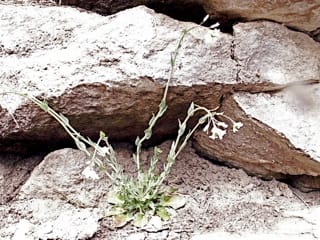  Photo: Chick Keller 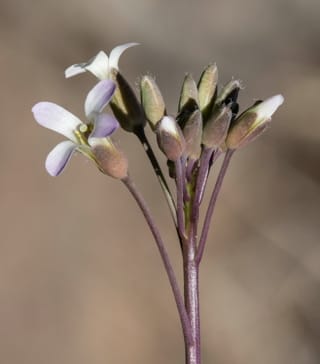  Photo: Craig Martin 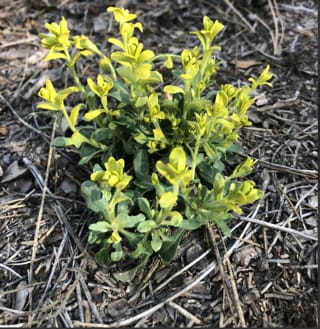  Photo: false flowers by Christina M. Selby | Fendler's RockcressARFEF (Boechera fendleri, Arabis fendleri)Family: Brassicaceae (Mustards) Size: up to 4 in (10 cm) Growth: forb/herb, subshrub; perennial Blooms: Mar 30 - May 27 Flower: simple; white, turning pink to purple with age; 4 petals Leaf: dicot; basal leaves broadly oblanceolate with forked hairs; upper leaves smooth Fruit: pedicels; horizontal or curving downward Status: native; common Habitat: ponderosa --- rocky slopes in pine forests, pinyon-juniper woodlands, scrub oak This is tall, slender plants that is often attacked by a rust fungus (see bottom photo). The fungal hyphae germinate and then parasitize nutrients from the host plant. The fungus causes the plant to produce both a scent and nectar to attract insects that then carry the fungus spores to another plant. Info Photos Distribution |
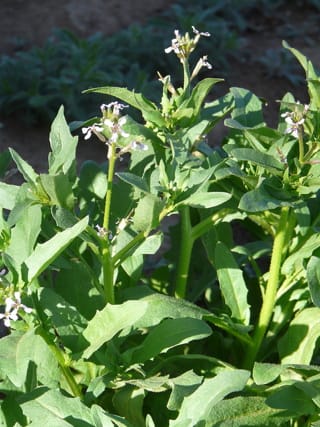  Photo: Rebecca Shankland 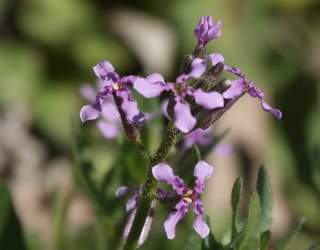  Photo: J.N. Stuart | Crossflower, Blue Mustard, Purple MustardCHTE2 (Chorispora tenella)Family: Brassicaceae (Mustards) Size: 6 - 24 in (15 - 61 cm) Growth: forb/herb; annual Blooms: Mar 24 - Jun 19 Flower: simple; blue to purple; 4 petals; borne on racemes Leaf: dicot; grey-green; wavy-edged with teeth Fruit: long pods that curve upward; reddish brown seeds Status: naturalized plant; locally common Habitat: disturbed soil --- semi-deserts, foothills, fields, woodlands Typical location: White Rock This plant originated in Europe and Asia but was introduced in the US long ago. It is classified as a noxious weed in many areas due to its ability to take over open fields in the early spring. Has a strong musky odor. Info Photos Distribution |
  Photo: Mike Anderson   Photo: Chick Keller 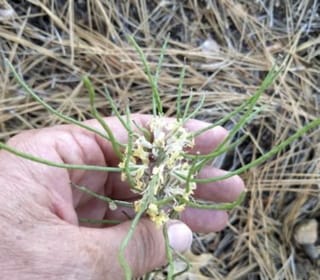  Photo: Dan Rideout | Sanddune Wallflower, Western Wallflower, Wallflower, Prairie RocketERCA14 (Erysimum capitatum)Family: Brassicaceae (Mustards) Size: 12 - 24 in (30 - 61 cm) Growth: forb/herb; biennial, perennial Blooms: Apr 15 - Jul 12 Flower: simple; yellow though may show as orange in some areas;4 flat petals; dense, rounded flower cluster on the top of the plant Leaf: dicot; long, thin leaves; rosette at the bottom of the plant; Fruit: narrow and nearly vertical seed pods Status: native; locally common Habitat: mixed conifer --- semi-desert to alpine, woodlands, meadows A highly variable species, often one of the first flowers in spring. The plant grows in a small group, often scattered over a large area. Info Photos Distribution |
  Photo: Craig Martin 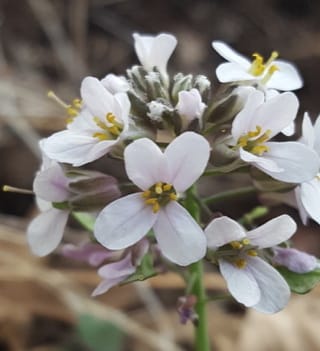  Photo: Alex Abair | Fendler's Pennycress, Alpine Pennycrest, Wild CandytuftNOMOF (Noccaea fendleri)Family: Brassicaceae (Mustards) Growth: forb/herb; perennial Blooms: Mar 15 - May 14 Flower: simple; white with a little pink; flowers grow in dense clusters Leaf: dicot; small, arrow-shaped leaves; evenly spaced and growing on the main stem of the plant Fruit: two fused carpels with two seeds in each half Status: native; uncommon Habitat: mixed conifer --- lower montane through alpine, woodlands, openings, meadows Typical location: Valle Canyon Grows in large patches with few other plants around. It starts to flower when still close to the ground but the continues to elongate as it grows. Info Photos Distribution |
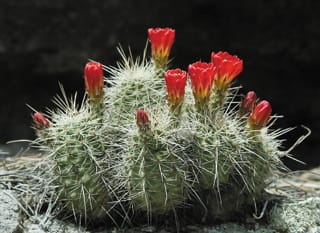  Photo: J. Howell 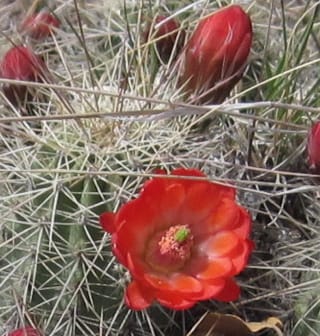  Photo: Akkana Peck | Scarlet Hedgehog Cactus, Claret Cup CactusECCOC (Echinocereus coccineus)Family: Cactaceae (Cacti) Size: up to 16 in (41 cm) Growth: shrub; perennial Blooms: Apr 20 - Jun 22 Flower: simple; red with green stigma; rounded petals Leaf: dicot; leaves replaced by spines Fruit: greenish or yellowish to pinkish Status: native; uncommon Habitat: pinyon-juniper --- semi-desert, woodlands, openings The plant grows in sprawling clusters (potentially up to 100 members) with low-to-medium spine cover and somewhat flabby stems. Info Photos Distribution |
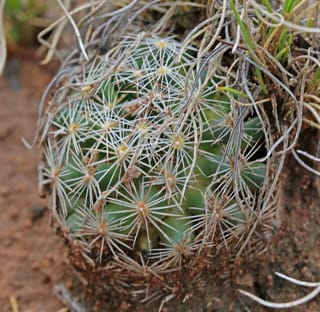  Photo: Jerry Oldenettel 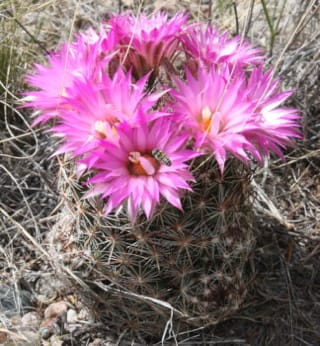  Photo: Akkana Peck | Spinystar, Pincushion Cactus, Beehive CactusESVI2 (Escobaria vivipara, Coryphantha vivapara)Family: Cactaceae (Cacti) Size: up to 6 in (15 cm) Growth: shrub; perennial Blooms: Apr 15 - Jun 15 Flower: simple; pink; arise from tubercles at the top of the plant; conspicuously fringed Leaf: dicot; up to 40 white radial spines and several darker, central spines pointing outwards at various angles Fruit: green, ovoid fruits that turn dull brownish red; juicy Status: native; uncommon Habitat: pinyon-juniper --- dry valleys, foothills, grasslands A favorite as an ornamental in nurseries, this cactus can be found at elevations up to 8,800 ft (2,700 m) as a single plant or small cluster of 20 or more stems. It was a common food source, roasted or boiled, for some Native American cultures. Info Photos Distribution |
  Photo: Chick Keller 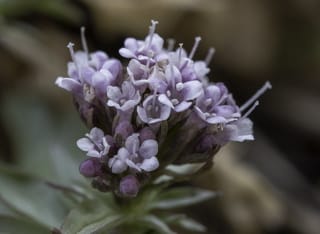  Photo: Craig Martin | Arizona Valerian, ValerianVAAR3 (Valeriana arizonica)Family: Caprifoliaceae (Honeysuckles) Size: 2 - 6 in (5 - 15 cm) Growth: forb/herb; perennial Blooms: Mar 19 - Jun 01 Flower: simple; pinkish white; tubular; arranged in a spherical cluster; 5 lobes Leaf: dicot; sparsely spaced leaves; opposite arrangement Fruit: achene-like with 1 seed Status: native; locally common Habitat: mixed conifer, ponderosa --- moist coniferous forests Typical location: Valle Canyon Found at upper elevations on north facing slopes. The plant is characterized by unbranched, stout but relatively short stems tapering to long stalks. Info Photos Distribution |
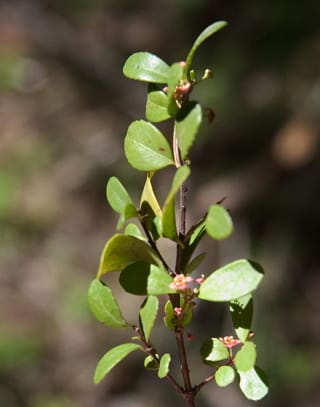  Photo: Mary Carole Williams 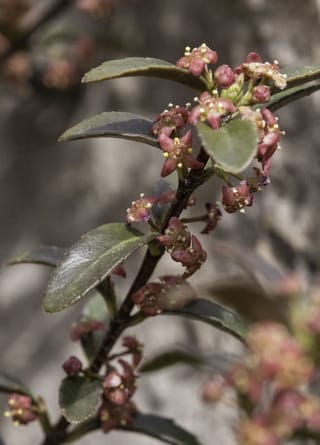  Photo: Craig Martin | Oregon Boxleaf, Mountain Lover, Myrtle BoxwoodPAMY (Paxistima myrsinites)Family: Celastraceae (Bittersweets) Size: 8 - 24 in (20 - 61 cm) Growth: shrub; perennial Blooms: Apr 18 - May 30 Flower: simple; red with yellow; cross-shaped; growing in a cluster around an axil; inconspicuous Leaf: dicot; evergreen leaves; toothed margins; opposite arrangement Fruit: cylindrical brown fruit capsules Status: native; common Habitat: mixed conifer, ponderosa --- foothills, montane, subalpine, woodlands. Typical location: Valle Canyon Oregon boxleaf is a low spreading shrub that looks like a miniature boxwood. It reproduces via seed, but it can also be propagated with cuttings. In the wild, it is a good source of food for a variety of animals. Info Photos Distribution |
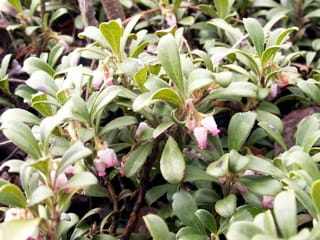  Photo: Chick Keller 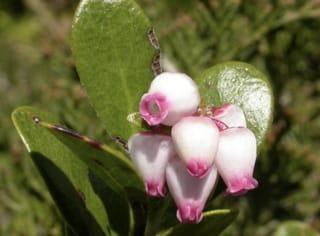  Photo: Lorraine Briddon 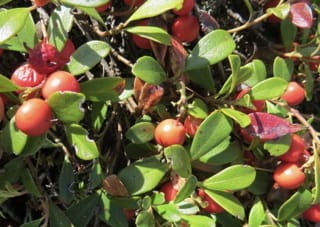  Photo: Don Sutherland | Kinnikinnick, BearberryARUV (Arctostaphylos uva-ursi)Family: Ericaceae (Heaths) Size: 2 - 12 in (5 - 30 cm) Growth: shrub; perennial Blooms: Mar 10 - May 08 Flower: simple; paink and white; urn-shaped on bright-red stems Leaf: dicot; shiny and small; thick, leathery, and paddle-shaped Fruit: drupes; bright red and glossy Status: native; locally common Habitat: ponderosa --- montane, alpine, woodlands Typical location: Kinnikinnick Park Its species name of uva-ursi means "grape of the bear” and indeed bears eats the fruit. Often forms very dense, pure stands of groundcover. Info Photos Distribution |
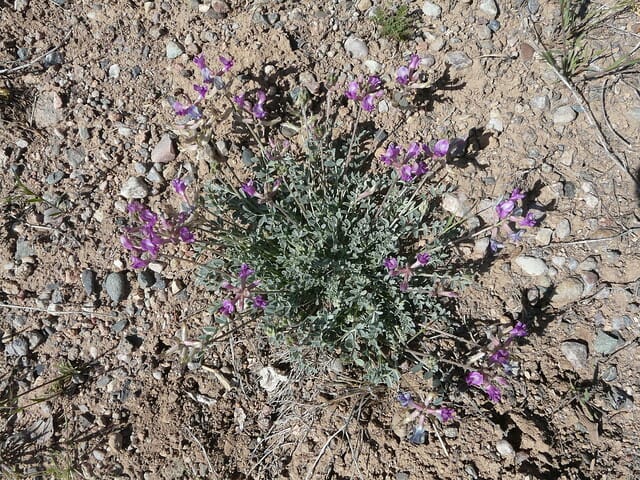  Photo: Rebecca Shankland 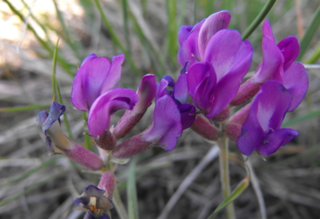  Photo: M. Weiss 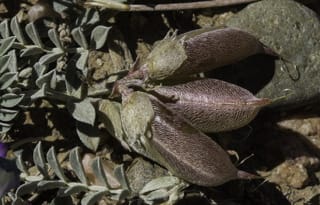  Photo: Craig Martin | Missouri MilkvetchASMI10 (Astragalus missouriensis)Family: Fabaceae (Peas) Size: 4 - 6 in (10 - 15 cm) Growth: forb/herb, subshrub; perennial Blooms: Apr 21 - May 19 Flower: simple; shades of purple and blue; short flower cluster on a thick stem with 3 to 10 stalked pea-shaped flowers Leaf: dicot; compound, elliptical leaves that a bend along the axis; covered with dense silvery-white to gray hairs Fruit: short, oblong seedpods with stiff hairs Status: native; common Habitat: pinyon-juniper --- semi-desert, woodlands, shrubs, openings Typical location: White Rock This plant has a wide range and is found in a band that ranges from Texas and New Mexico in the south up into Canada in the north. It can accumulate selenium, which makes it not very palatable to livestock but is not considered to be toxic like some of its close relatives. Info Photos Distribution |
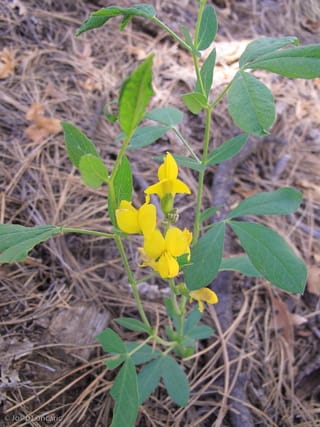  Photo: Josip Loncaric 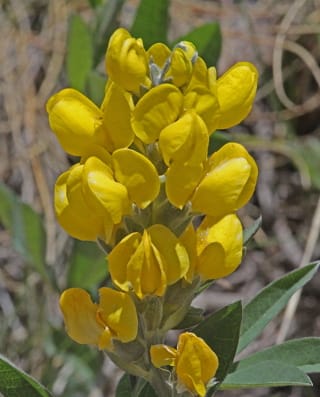  Photo: Jerry Oldenettel | Mountain Goldenbanner, Golden Pea, Montane Goldenbanner, BuckbeanTHMO6 (Thermopsis montana, Thermopsis rhombifolia)Family: Fabaceae (Peas) Size: 1 - 4 in (3 - 10 cm) Growth: forb/herb; perennial Blooms: Apr 14 - Jun 11 Flower: simple; yellow; held on a spike above leaves in elongated clusters Leaf: dicot; 3 long, oval leaflets arranged on a stem compound Fruit: long, brown upright pod which dries to black Status: native; common Habitat: ponderosa --- semi-desert, foothills, woodlands, meadows, open areas The plant has purplish stems with a white coating. The flowers which are particularly attractive to bumblebees have been used as a source of yellow dye. Info Photos Distribution |
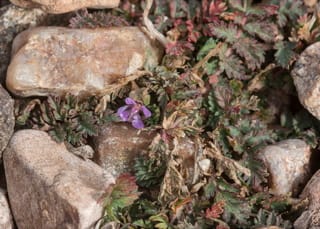  Photo: Craig Martin 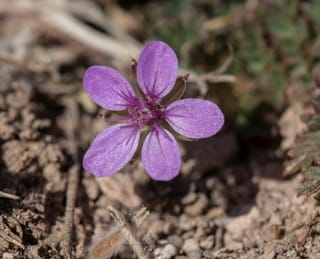  Photo: Craig Martin 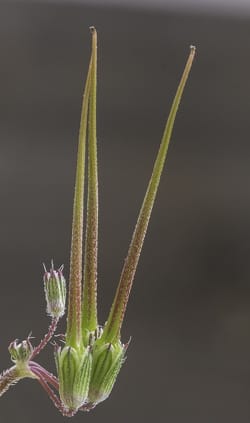  Photo: Craig Martin | Redstem Stork's Bill, Redstem Filaree, Pinweed, CranesbillERCI6 (Erodium cicutarium)Family: Geraniacea (Geraniums) Size: 6 - 12 in (15 - 30 cm) Growth: forb/herb; annual, biennial Blooms: Jan 02 - Dec 30 Flower: simple; pink, often with dark spots; arranged in loose clusters with 10 filaments Leaf: dicot; deeply cleft; fern-like Fruit: long, narrow, pointed seed pods Status: naturalized plant; common Habitat: disturbed soil --- desert scrub, grasslands, oak woodlands, semi-desert grassland, lawns, gardens; more common at lower elevations It was introduced into California from the Mediterranean Basin in the eighteenth century. The entire plant is edible and resembles a parsley when picked young. It is considered to be a weed in some areas. Info Photos Distribution Weed Guide |
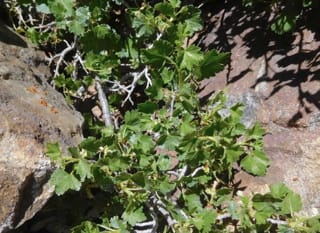  Photo: Ellen Hildebrandt 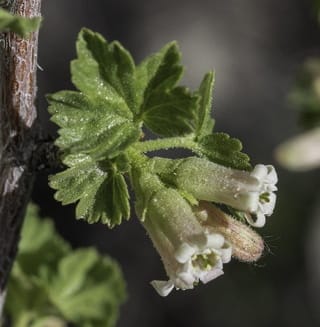  Photo: Craig Martin 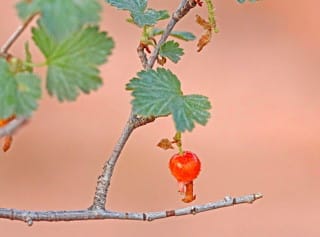  Photo: Jerry Oldenettel | Wax Currant, Western Red Currant, White Squaw CurrantRICE (Ribes cereum)Family: Grossulariaceae (Currants) Size: 8 - 80 in (20 - 203 cm) Growth: shrub; perennial Blooms: Apr 01 - May 30 Flower: simple; pink and white; bell-shaped; clusters with 2 to 9 flowers Leaf: dicot; light-green foliage; turns yellow in autumn Fruit: bright-red berries with dried flower remnant at the end Status: native; common Habitat: ponderosa --- grows in mountain forests, sagebrush, woodlands Compact, rounded shrub with cherry-like bark. The plant is aromatic, with a "spicy" scent. The berries are edible but considered to be fairly tasteless. Info Photos Distribution |
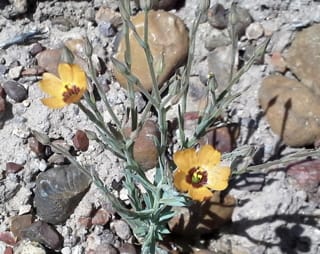  Photo: wingedchimera 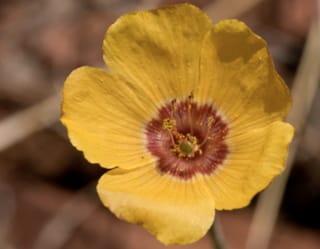  Photo: Peter Alexander | Plains FlaxLIPU4 (Linum puberulum, Cathartolinum puberulum)Family: Linaceae (Flax) Size: up to 2 in (5 cm) Growth: forb/herb; annual Blooms: Apr 14 - May 14 Flower: simple; orange with red center; open flower with five petals Leaf: dicot; greenish-gray; very narrow, almost grasslike Fruit: ovoid capsule that splits into 5 parts on maturation Status: native; uncommon Habitat: ponderosa --- semi-desert, foothills, openings, meadows Typical location: Overlook Park, White Rock Canyon Plant most often seen along canyon rims, often growing is sparse patches. The flower petals are so loosely attached that the least amount of movement can cause them to fall off. Native Americans have used the plant to treat eye inflammation. Info Photos Distribution |
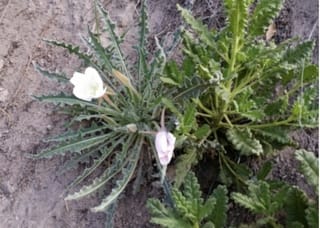  Photo: Craig Martin 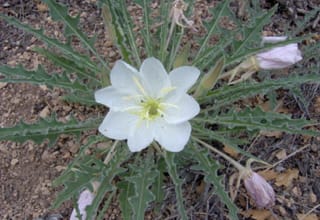  Photo: Barbara Calef | Tufted Evening Primrose, Fragarent Evening Primrose, Gumbo Evening PrimroseOECA10 (Oenothera caespitosa)Family: Onagraceae (Evening Primroses) Size: up to 8 in (20 cm) Growth: forb/herb, subshrub; perennial Blooms: Mar 27 - Jul 17 Flower: simple; white; 4 petals that are deeply notched at tip; flowers become pink as they age Leaf: dicot; long, thin, lobed leaves; irregularly lobed or toothed Fruit: rough seedpods; inconspicuous Status: native; uncommon Habitat: pinyon-juniper --- foothills, montane, woodlands, openings Typical location: Anniversary Trail Spreads by underground roots and often forms large colonies. Flowers open with the evening and wither to pink by the next afternoon. Dependent on hawkmoths for pollination. Info Photos Distribution |
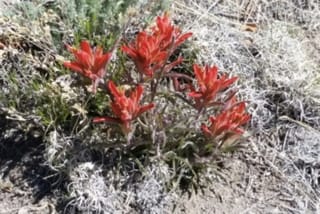  Photo: Craig Martin 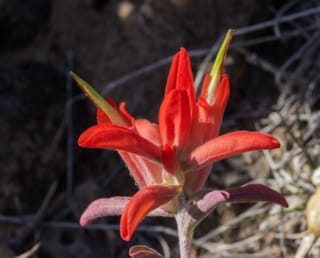  Photo: Craig Martin | Wholeleaf Indian Paintbrush, Squawfleather, Southwestern Indian Paintbrush, Cola de BorrejoCAIN14 (Castilleja integra)Family: Orobanchaceae (Broomrapes) Size: up to 16 in (41 cm) Growth: forb/herb, subshrub; perennial Blooms: Apr 18 - Oct 20 Flower: simple; Red or orange specialized leaves or bracts form on spikes; flowers are a small green tubes protruding above the bracts Leaf: dicot; Narrow, unlobed, undivided; tinges of light purple on some Fruit: capsule filled with numerous seed Status: native; common Habitat: pinyon-juniper --- foothills, montane, shrublands, woodlands Typical location: Canyon Rim Trail paved section, Quemazon Trail The common name "wholeleaf" refers to the lack of lobes on the leaves and bracts. The plant’s roots will grow and penetrate those of other plants in order to obtain nutrients. The stems of the plant have white hairs. The Zuni used to mix the roots with minerals to make a black dye. Info Photos Distribution |
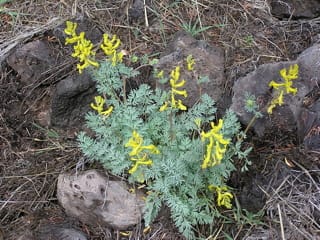  Photo: Rebecca Shankland 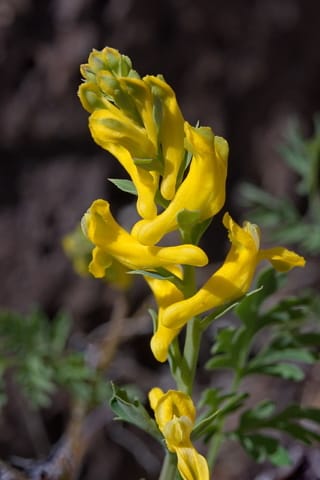  Photo: Craig Martin 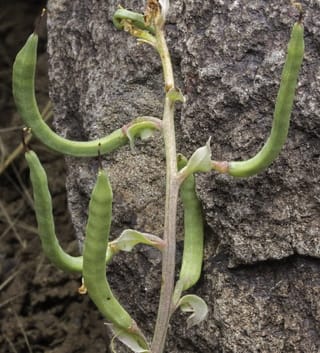  Photo: Craig Martin | Scrambled Eggs, Golden Smoke, Golden CorydalisCOAU2 (Corydalis aurea)Family: Papaveraceae (Poppies) Size: up to 18 in (46 cm) Growth: forb/herb; annual, biennial Blooms: Apr 01 - Aug 18 Flower: simple; yellow; spur at the back of each flower; form tightly packed clusters with up to 30 flowers Leaf: dicot; blue-green leaves divided into leaflets with oval or diamond lobes Fruit: cylindrical capsules; curve upward Status: native; common Habitat: mixed conifer, pinyon-juniper, ponderosa --- montane, subalpine, woodlands Typical location: Valle Canyon Often mistaken for a pea rather than a poppy. The stems are weak and are often supported by vegetation or rocks. Info Photos Distribution |
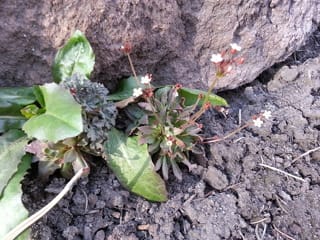  Photo: Craig Martin 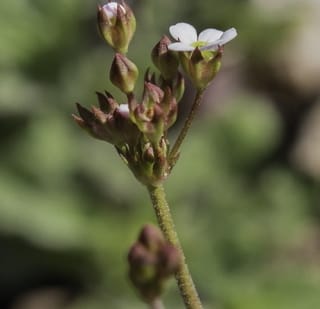  Photo: Craig Martin 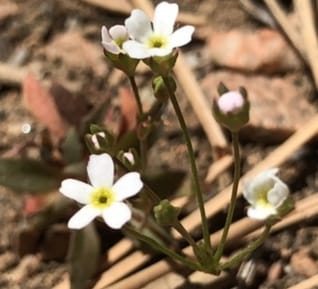  Photo: Christina M. Selby | Pygmyflower Rockjasmine, Rock Jasmine, RockJasmine, Northern Fairy CandelabraANSE4 (Androsace septentrionalis)Family: Primulaceae (Primroses) Size: 6 - 10 in (15 - 25 cm) Growth: forb/herb; annual, perennial Blooms: Mar 19 - Sep 01 Flower: simple; white with yellow center; enclosed by a green or reddish calyx; 5 petals Leaf: dicot; simple leaves formed in a rosette Fruit: small, smooth, round capsule containing about 20 seeds Status: native; common Habitat: mixed conifer, ponderosa --- foothills, montane, subalpine, meadows, open woods Tiny plant often obscured by others. It turns shades of red shortly after finishing blooming. Can be found up to 11,000 ft (3,400 m). Info Photos Distribution |
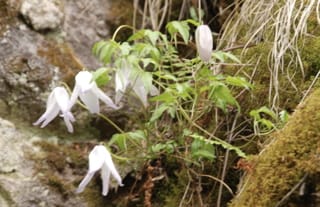  Photo: Damian Tighe 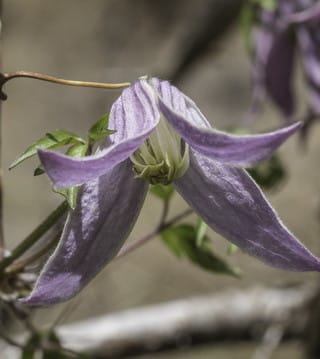  Photo: Craig Martin 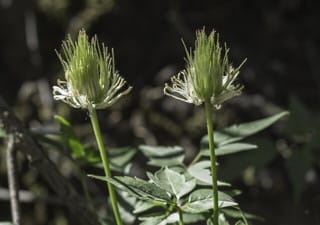  Photo: Craig Martin | Rock Clematis, Spring ClematisCLCO2 (Clematis columbiana)Family: Ranunculaceae (Buttercups) Size: 5 - 7 in (13 - 18 cm) Growth: vine; perennial Blooms: Apr 05 - May 22 Flower: simple; purple to white; hairy with prominent veins and pointed sepals; flowers often point downward Leaf: dicot; oval to heart-shaped; trifolate Fruit: plumed seed heads Status: native; uncommon Habitat: mixed conifer, ponderosa --- foothills, montane, woodlands Typical location: Pajarito Trail This is a spring-blooming vine that is usually not noticeable from the trail, preferring deep forest shade. The stems climb along the ground and up over low bushes and tree trunks. Info Photos Distribution |
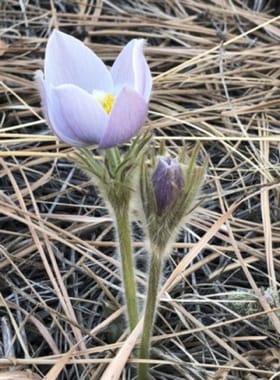  Photo: Christina M. Selby 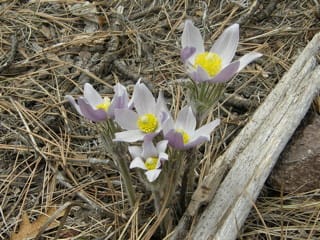  Photo: Chick Keller 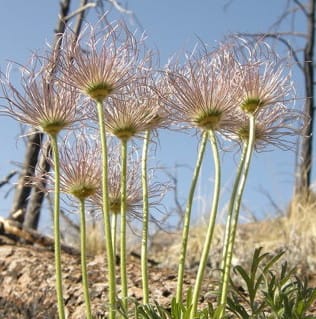  Photo: Chick Keller | Eastern Pasqueflower, American PasqueflowerPUPA5 (Pulsatilla patens, Anemone patens)Family: Ranunculaceae (Buttercups) Size: 3 - 18 in (8 - 46 cm) Growth: forb/herb; perennial Blooms: Mar 16 - Jun 19 Flower: simple; blue, purple and/or white; single cup-shaped flower on each stalk; 6 petals Leaf: dicot; deeply cut basal leaves; 3 unstalked leaves with linear segments surround each flower Fruit: feathery, silky fruiting head Status: native; common Habitat: ponderosa --- dry, open, and rocky low to high montane forests and meadows Typical location: Pajarito Trail, Perimeter Trail, Rendija Canyon Plants often occur in large colonies. They elongate as they mature. Although the plant was used by Native Americans as a medicine it is highly toxic. Info Photos Distribution |
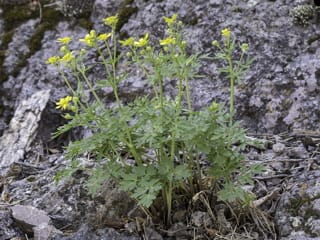  Photo: Craig Martin 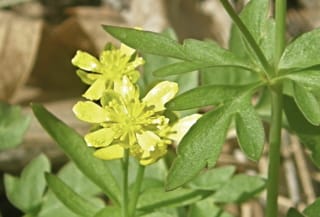  Photo: Chick Keller | Tadpole Buttercup, Los Alamos ButtercupRARA (Ranunculus ranunculinus)Family: Ranunculaceae (Buttercups) Size: 3 - 6 in (8 - 15 cm) Growth: forb/herb; perennial Blooms: Apr 21 - Jun 01 Flower: simple; yellow; starlike; 5 or 6 petals; sepals spreading from the base Leaf: dicot; basal leaves oval to semi-circular; leaflets lobed with smooth margins Fruit: heads of small or one-seeded fruits (achenes) Status: native; locally common Habitat: ponderosa --- montane, open rocky slopes, sage Typical location: Los Alamos Common on north-facing canyon slopes in restricted areas in a few states. Appears soon after snow-melt. Info Photos Distribution |
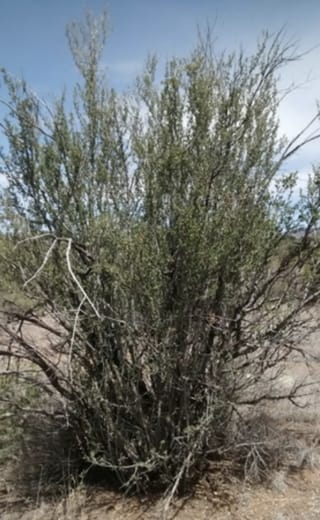  Photo: Jess Demoss 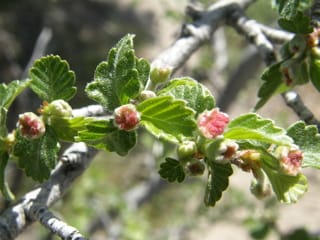  Photo: Chick Keller 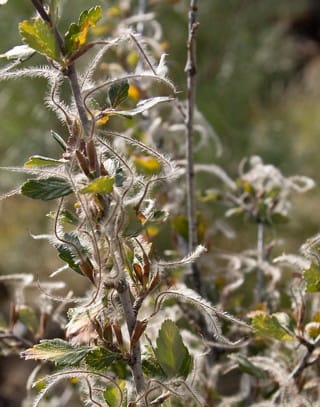  Photo: Mary Carol Williams | Alderleaf Mountain Mahogany, Silverleaf, Mountain MahoganyCEMO2 (Cercocarpus montanus)Family: Rosaceae (Roses) Size: 78 - 156 in (198 - 396 cm) Growth: shrub, tree; perennial Blooms: Apr 15 - May 19 Flower: simple; red and yellow; non-showy; trumpet-shaped Leaf: dicot; leaves almost evergreen in nature; dark on top and fuzzy on the bottom Fruit: feathery, silvery-white fruits Status: native; common Habitat: pinyon-juniper --- rocky hillsides, cliffs, open woods, mesas The plant fixes nitrogen and is good for revegetation and erosion control. The foliage is a favorite of deer. In the wild, the plant generally remains as a shrub and does not obtain a tree-like form. Info Photos Distribution Tree Guide |
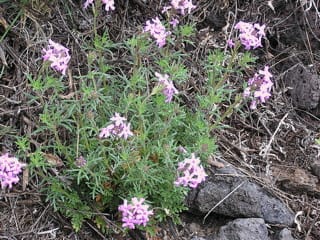  Photo: Rebecca Shankland 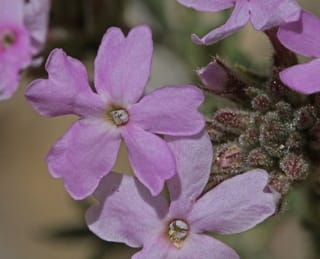  Photo: Jerry Oldenettel | Dakota Mock Vervain, Dakota Verbena, Prairie VerbenaGLBI2 (Glandularia bipinnatifida)Family: Verbenaceae (Verbenas) Size: 9 - 12 in (23 - 30 cm) Growth: forb/herb; annual, perennial Blooms: Mar 10 - Jun 01 and Sep 15 - Oct 15 Flower: simple; pink to purple; grow in rounded clusters Leaf: dicot; finely dissected, into segments; opposite arrangement Fruit: 4 nutlets enclosed in a calyx Status: native; locally common Habitat: pinyon-juniper --- semi-desert, open areas Typical location: Red Dot Trail, White Rock Canyon There plants can often can be seen along the trail or in old lava flows. The leaves tend to lean outward from the center as the plant grows and the stems are reddish. Info Photos Distribution |
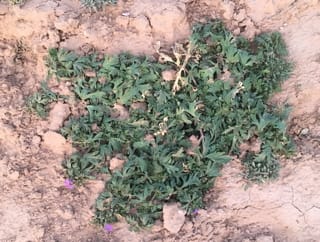  Photo: annagypsy   Photo: Craig Martin | Davis Mountain Mock Vervain, Desert Verbena, Wright's VerbenaGLWR (Glandularia wrightii)Family: Verbenaceae (Verbena) Size: 6 - 12 in (15 - 30 cm) Growth: forb/herb; annual, perennial Blooms: Mar 01 - Sep 30 Flower: simple; light to dark pink; narrow tube that opens abruptly into 5 notched lobes with 2 close together Leaf: dicot; deeply lobed leaves at opposite intervals Fruit: acorn-shaped seed Status: native; common Habitat: montane, mountain meadow --- semi-desert, foothills, woodlands Typical location: Red Dot Trail Plant has greenish-red stems that are covered in short hairs and square in cross-section. Stems are erect, though may lean at an angle when flowering. Flowers form round clusters. Info Photos Distribution |
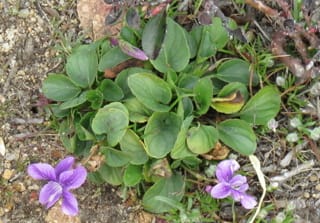  Photo: Krissa Klein 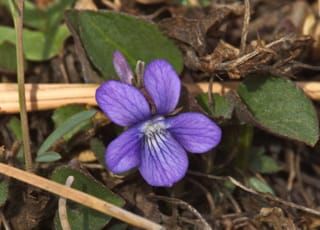  Photo: Craig Martin | Hookedspur Violet, Blue Violet, Hook Violet; Dog VioletVIAD (Viola adunca)Family: Violaceae (Violets) Size: up to 12 in (30 cm) Growth: forb/herb; perennial Blooms: Apr 05 - Jul 12 Flower: simple; blue to purple; single flowers growing on long, thin stems; 5 petals; top 2 may have spurs Leaf: dicot; heart-shaped; wavy margins Fruit: hanging ovoid capsule with dark brown seeds Status: native; common Habitat: mixed conifer --- woodlands, montane, subalpine, alpine Scores of flowering plants commonly cover large areas. Often hidden among taller grasses and plants. Info Photos Distribution |
